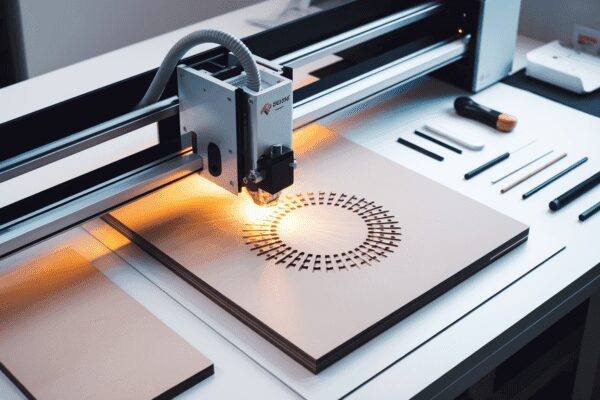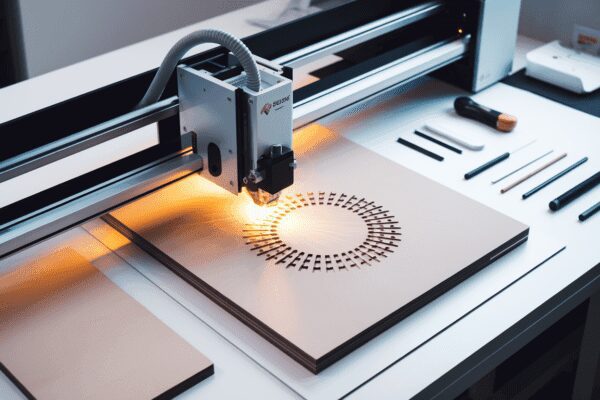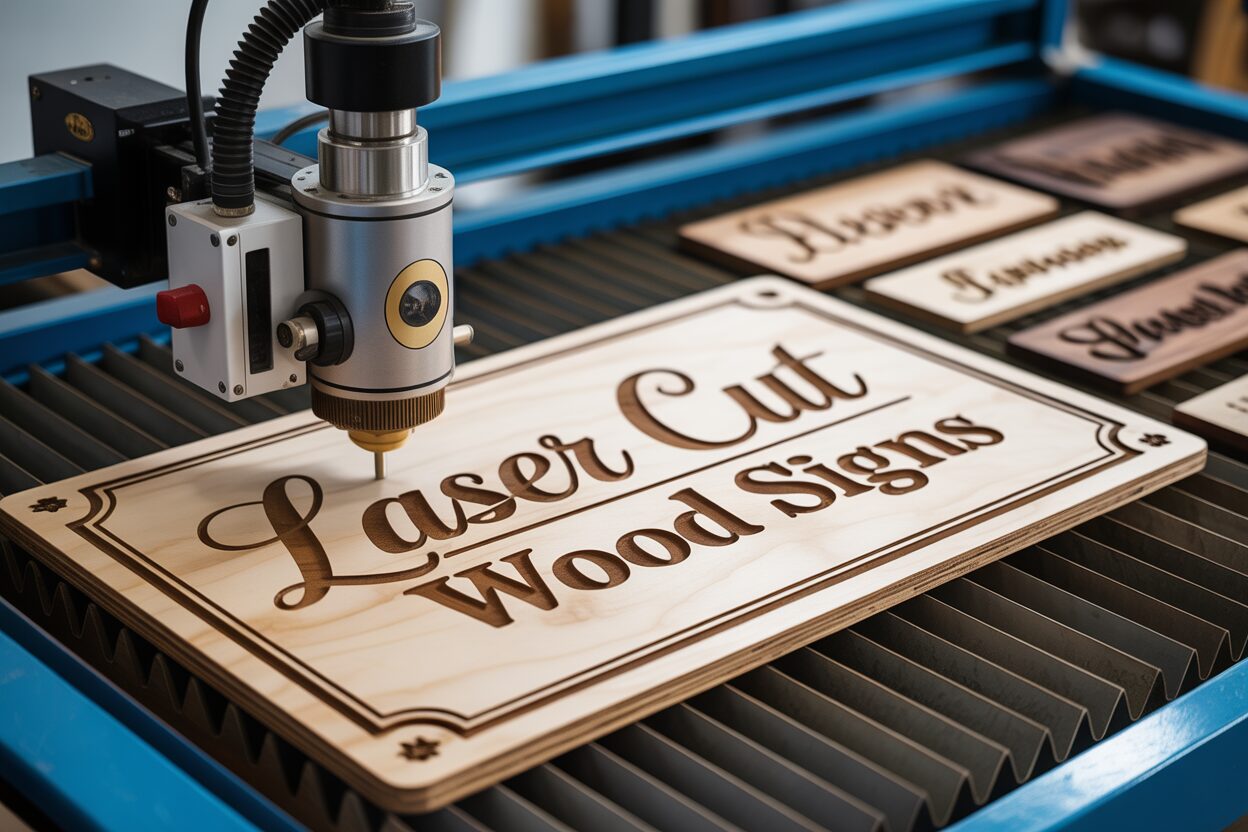A Guide to Crafting Beautiful Laser Cut Wood Signs
Estimated reading time: 8 minutes
Key Takeaways
- Wood Selection is Foundational: Your choice between consistent engineered woods like Birch Plywood and the natural beauty of solid hardwoods like Maple or Walnut will define your sign’s final look and the laser settings required.
- Precise Digital Design is Non-Negotiable: A clean vector file is crucial. Key steps include converting text to paths, welding script fonts, and ensuring all cut lines are closed paths to avoid errors.
- Test Your Settings: Never assume laser settings. Always run a material test grid to determine the optimal power and speed for your specific piece of wood, saving time and preventing wasted material.
- Finishing Makes the Difference: Post-processing steps like sanding to remove smoke residue, staining or painting for contrast, and applying a protective sealant are what elevate a simple cutout to a professional, durable sign.
Welcome to the world of wooden sign making, where creativity meets precision. This guide will walk you through everything you need to know about creating your own laser cut wood signs. From selecting the right materials and design files to the final finishing touches, you’ll learn how to produce professional-quality, personalized wood signs for your home, business, or as unique gifts.
Choosing the Right Wood for Your Sign
The foundation of any beautiful laser cut wood sign is, quite literally, the wood itself. Your choice of material will dictate not only the final aesthetic but also how you approach the cutting and engraving process. Different species react uniquely to the laser’s heat, resulting in varied colors, depths, and textures. Understanding these differences is key to transforming your digital design into a stunning physical creation.
Engineered Woods vs. Solid Hardwoods
Your first major decision is between engineered woods like plywood and MDF, or solid hardwoods. For beginners or those undertaking large-scale diy wood signs, engineered woods offer a fantastic balance of cost and consistency.
- Birch Plywood: This is arguably the most popular choice for laser cutting. Its light, uniform color provides an excellent canvas for high-contrast engraving, making text and images pop. Because it’s a layered product, it is dimensionally stable and less prone to warping than solid wood. However, the laser will expose these layers along the cut edge, creating a striped look that you may or may not find desirable. Be aware of potential internal voids or glue pockets in lower-grade plywood, which can cause the laser to cut inconsistently.
- MDF (Medium-Density Fiberboard): MDF is the king of consistency. It has no grain and a perfectly uniform density, which means it cuts and engraves with predictable smoothness. It’s also very affordable. The downside is that its engraving results in a muted, low-contrast brown tone with little character. It is essentially compressed sawdust and glue, so it is not as durable as real wood and must be sealed or painted for a finished look.
For premium, high-end personalized wood signs, nothing compares to the beauty of solid hardwood. Each piece is unique, bringing natural character to your project.
- Maple: A hard, dense wood with a very light color and subtle grain. It engraves beautifully, producing a rich, dark brown contrast that is sharp and clean. Its density, however, means it requires more laser power to cut and can be prone to “haloing” or smoke staining around the engraving if not masked properly.
- Cherry: Known for its warm, reddish-brown hue that deepens wonderfully with age. Cherry engraves with a satisfyingly dark, rich tone. It is slightly softer than maple, making it a bit easier and faster to cut. Its elegant appearance makes it a favorite for commemorative or decorative signs that require a touch of warmth.
- Walnut: This is a luxurious, dark hardwood. The engraving on walnut is more subtle and tonal rather than high-contrast, creating a sophisticated, understated look. The darker wood does a great job of hiding any potential smoke residue. While it is one of the more expensive options, its rich color makes it perfect for high-value signs.
Key Factors in Wood Selection
Beyond the species, pay close attention to the specific piece of wood you select. For best results, look for boards that are as flat as possible; warped wood will lead to an unfocused laser beam and inconsistent cut depths. Examine the grain pattern and check for knots, as these dense areas can disrupt both cutting and engraving. The thickness of the wood is also a crucial factor. A 1/8-inch (3mm) board is great for intricate cutouts and layered designs, while a 1/4-inch (6mm) board provides a more substantial, durable feel for a standalone sign. Always start with unfinished wood, as pre-applied finishes can release harmful fumes and interfere with the laser’s performance, giving you the freedom to stain and seal your project to perfection later.
From Idea to Design: Preparing Your Laser Cut Sign Files
With your chosen wood ready, the next step is to translate your vision into a digital blueprint that the laser cutter can understand. This process is where the artistry of wooden sign making truly begins. The laser cutter is a precise tool, but it only does exactly what the file tells it to do. Therefore, creating a clean, well-prepared design file is paramount to achieving a professional result. The foundation of any laser-ready design is vector graphics. Unlike pixel-based images (like JPEGs), vectors are made of mathematical paths, lines, and curves. This allows the laser to follow a precise cutting path and scale the design to any size without losing quality. Popular software for creating these files includes Adobe Illustrator, a professional industry standard, and Inkscape, a powerful and free alternative.
Crafting Your Design for Laser Precision
When you begin designing, you must think in terms of laser actions: cutting and engraving. In your software, you’ll typically assign different colors to distinguish these operations. A common convention is to use a thin red line (e.g., 0.01mm stroke) for cut lines and a solid black fill for areas to be engraved.
- Text and Fonts: Choosing the right font is crucial for custom wood signs. For engraved text, almost any font will work. For cut-out text, however, avoid overly thin or delicate fonts, as the resulting wooden letters can be fragile. A critical step for any text is to convert it to paths or create outlines. This turns the editable text into a fixed vector shape, ensuring the laser machine interprets it correctly, even if it doesn’t have that specific font installed. For script fonts, you must also “weld” or “unite” the letters so they cut out as a single, connected piece rather than individual, overlapping letters.
- Vector Graphics: When creating or modifying graphics, ensure all cut lines are continuous, closed paths. An open or broken path will confuse the laser, resulting in an incomplete cut. Also, be mindful of “islands”—the enclosed parts of letters like ‘o’ or ‘B’. If you cut these letters out of a solid sign, their centers will fall out unless you use a “stencil” font or add small connector tabs to your design.
If designing from scratch feels daunting, don’t worry. The internet is a vast resource for inspiration and ready-made files. Websites like Pinterest and Etsy are filled with ideas for custom wood signs. You can also purchase high-quality, pre-vetted laser cut sign files from online marketplaces. Using a pre-made file can be a huge time-saver and guarantees that the design is already optimized for laser cutting, allowing you to focus on the hands-on process of bringing the sign to life on your chosen piece of wood.
The Laser Cutting and Engraving Process
Once your design file is perfected, it’s time to bring it into the physical world. This is where you interface with the laser cutter, a powerful tool that demands respect and precision. Before you even think about pressing the ‘start’ button, safety must be your top priority. Wood is flammable, and a laser is a concentrated heat source. Never, ever leave a laser cutter unattended while it is operating. Ensure your machine’s ventilation system is running correctly to exhaust smoke and fumes outside; burning wood, and especially the glues in plywood or MDF, can release harmful particulates. Keep a CO2 or ABC fire extinguisher within easy reach. The machine’s lid is designed to protect your eyes from the laser beam, so always keep it closed during operation.
Dialing in Your Settings
With safety checks complete, you can prepare the machine for your laser cut wood sign. Place your wood on the laser bed, ensuring it lies completely flat to maintain a consistent distance from the laser head. The next critical step is focusing the laser. An accurately focused laser beam creates a tiny, concentrated point of energy, resulting in clean cuts and sharp engravings. An unfocused beam is wider and weaker, leading to charred, angled edges and blurry details. Most machines have a tool or an auto-focus feature to help you set the correct focal distance from the laser nozzle to the surface of your wood.
The magic of laser cutting lies in balancing three key variables: power, speed, and for rastering, DPI (dots per inch).
- Power: This determines the intensity of the laser beam. Higher power cuts deeper and engraves darker.
- Speed: This is how fast the laser head moves. Slower speeds allow the laser to dwell on one spot longer, resulting in a deeper cut or darker engrave.
These settings are inversely related and vary significantly between wood types. Hard, dense wood like maple requires more power or a slower speed to cut through than a softer wood or thinner plywood. The absolute best practice for any new material is to run a “material test grid.” This is a small file with a series of squares that runs at different combinations of power and speed, allowing you to see exactly which settings produce the perfect light engrave, dark engrave, and clean cut on your specific piece of wood. This simple test saves countless hours of frustration and prevents you from wasting a beautiful piece of hardwood on a failed cut.
Vector Cutting vs. Raster Engraving
Your laser software will interpret your design file based on the properties you assigned.
- Raster Engraving: For areas with a solid fill (like the black-filled text in your design), the laser will operate in raster mode. The laser head moves back and forth horizontally, like a printer, firing the laser beam to burn away the top layer of wood dot by dot. This is used to create filled-in shapes and detailed images.
- Vector Cutting: For lines with a specific stroke thickness and color (like your thin red outlines), the machine uses vector mode. The laser follows these paths precisely, like a drag knife, to cut all the way through the material or to score a line on the surface.
Typically, the laser job is ordered to perform all engraving passes first, followed by the vector cutting passes. This ensures that your design is fully engraved before the pieces are cut out and potentially shift. Once you send the file to the machine, turn on the ventilation, close the lid, and monitor the process as your diy wood sign comes to life.
Finishing and Assembling Your Custom Wood Sign
Your design has been flawlessly executed by the laser, but the piece that comes off the machine is still a raw canvas. The finishing and assembly stage is where you elevate your project from a simple cut-out to a professionally crafted personalized wood sign. This crucial post-processing work cleans up the piece, enhances the natural beauty of the wood, and protects it for years to come. The first step is almost always a gentle clean-up. The laser engraving process vaporizes wood, which can leave a light, smoky residue or “halo” on the surface around the engraved areas. To remove this, lightly sand the surface with a high-grit sandpaper (220 grit or higher). Use gentle, even pressure, moving with the grain of the wood. Be careful not to over-sand, as this can soften the sharp edges of your engraving. A soft brush or a puff of compressed air is perfect for clearing sawdust from the fine details of your design.
Adding Color and Contrast
Once the surface is clean and smooth, you can decide how to enhance its appearance. This is a key part of the wooden sign making process where your artistic choices come to the fore.
- Staining: To bring out the natural grain and add richness, apply a wood stain. For best results, especially on softer woods prone to blotching, use a pre-stain wood conditioner first. This helps the wood absorb the stain evenly. Apply the stain with a clean cloth, let it penetrate for the time recommended by the manufacturer, and then wipe off the excess. The stain will darken both the engraved and un-engraved areas, but the inherent contrast from the laser burn will remain, creating a deep, tonal effect.
- Painting: Paint offers endless possibilities for color and high contrast. You can paint individual elements like cut-out letters before assembly for crisp, clean lines. For engraved areas, you can carefully paint inside the lines with a fine-tipped brush. A popular and effective technique is to mask the entire surface of the wood with masking tape before laser cutting. The laser will cut through the tape, allowing you to paint the engraved areas, and then simply peel away the mask for a perfect finish with no bleeding.
Assembly and Final Touches
Many of the most striking signs involve assembling multiple layers. Creating 3D lettering is a fantastic way to add depth and a premium feel to your sign. To do this, you’ll laser cut the letters and the backer board as separate pieces. You can use contrasting wood species or paint the letters a different color. To attach them, apply a quality wood glue, like Titebond II, to the back of each letter and carefully place them on the backer board. For perfect alignment, you can lightly engrave the letter positions onto the backer board as a guide. When your sign is stained, painted, and assembled, the final step is sealing. A protective topcoat is essential to protect the wood from moisture, dust, and UV damage. Several coats of a clear spray-on polyurethane or lacquer (satin or semi-gloss are popular choices) will provide a durable, long-lasting finish that makes the colors and grain of your wood truly shine.
Conclusions
You now have the knowledge and skills to create stunning laser cut wood signs. With the right materials, a quality design file, and a bit of creativity, you can produce beautiful custom wood signs for any occasion. Don’t be afraid to experiment with different woods, finishes, and designs to develop your unique style in wooden sign making. Happy crafting!
Frequently Asked Questions
Q: What’s the best wood for a beginner making a laser cut sign?
A: Birch plywood is highly recommended for beginners. It’s cost-effective, has a consistent surface that’s great for learning on, and its light color provides excellent contrast for engraving, making your designs pop.
Q: Why do my cut-out letters fall apart when using a script font?
A: This common issue happens when the individual letters in a script font are not “welded” or “united” in your design software. You must use your software’s path functions to combine the overlapping parts of the letters into a single, continuous shape before sending the file to the laser. This ensures it cuts as one solid piece.
Q: What is a “material test grid” and why is it so important?
A: A material test grid is a small file that runs the laser at various combinations of power and speed on a scrap piece of your material. It’s crucial because every piece of wood is different. This test allows you to find the perfect settings for a clean cut, a light engrave, and a dark engrave, preventing you from ruining your main project piece and ensuring a high-quality result.
Q: How do I prevent smoke stains or “haloing” around my engraved designs?
A: First, ensure your machine’s ventilation and air assist are working optimally. A highly effective technique is to apply a layer of masking tape over the entire wood surface before you start the job. The laser cuts cleanly through the tape, and when you peel it off afterward, the smoke residue comes with it, leaving a perfectly clean surface underneath.


Subscribe to Our Newsletter
And enjoy FREE Download Files, SALE Alerts and Inspiring TIPS


A Comprehensive Guide to Laser Engraving Slate Coasters
A Guide to Crafting a Personalized Charcuterie Board
Creating the Perfect Personalized Charcuterie Board with a Laser Engraver
Valentine Love Captions: 6 Charcuterie Board Engraving Files…
$8.00Original price was: $8.00.$5.60Current price is: $5.60.(30% off)
Bee and Honey Jar Charcuterie Board Engraving File | PNG Download #007…
$4.00Original price was: $4.00.$3.20Current price is: $3.20.(20% off)
American Eagle Flag Laser Engraving File for Charcuterie & Cutting…
$4.00Original price was: $4.00.$2.80Current price is: $2.80.(30% off)
Bee & Hive Charcuterie Board Engraving – HQ PNG Download…
$4.00Original price was: $4.00.$2.80Current price is: $2.80.(30% off)